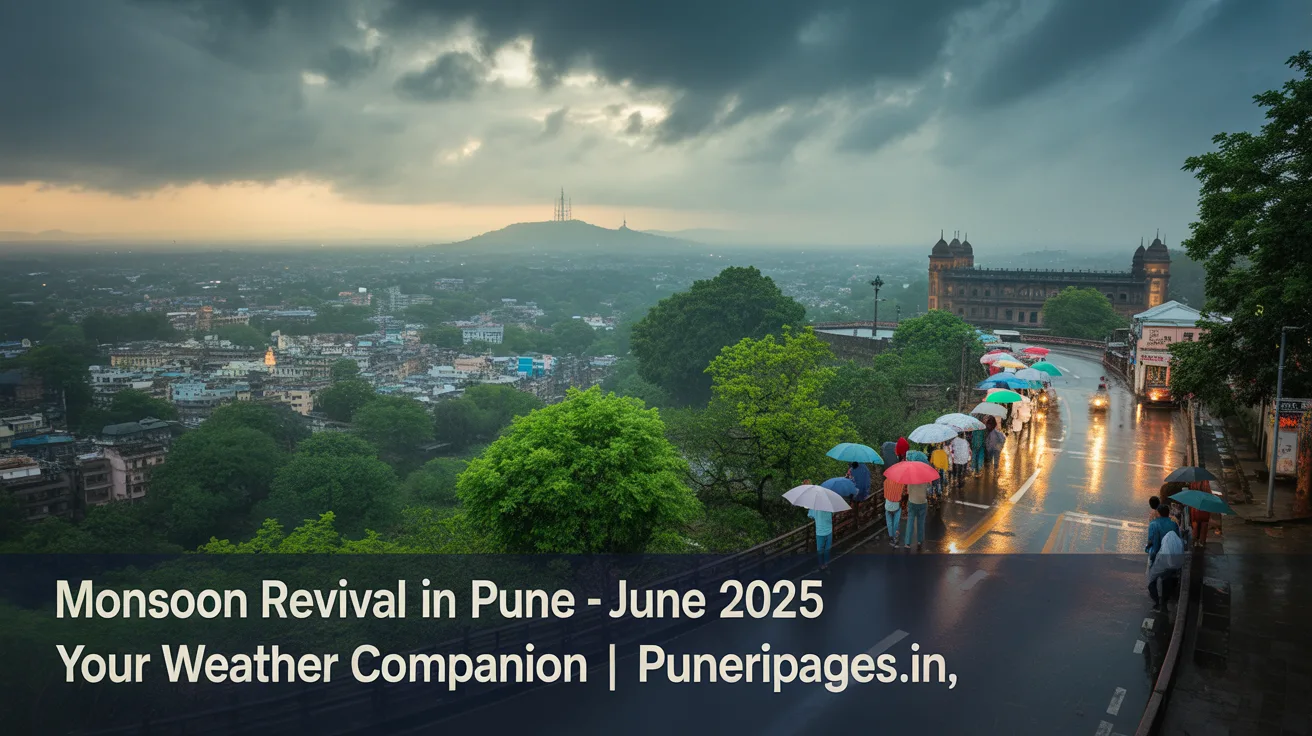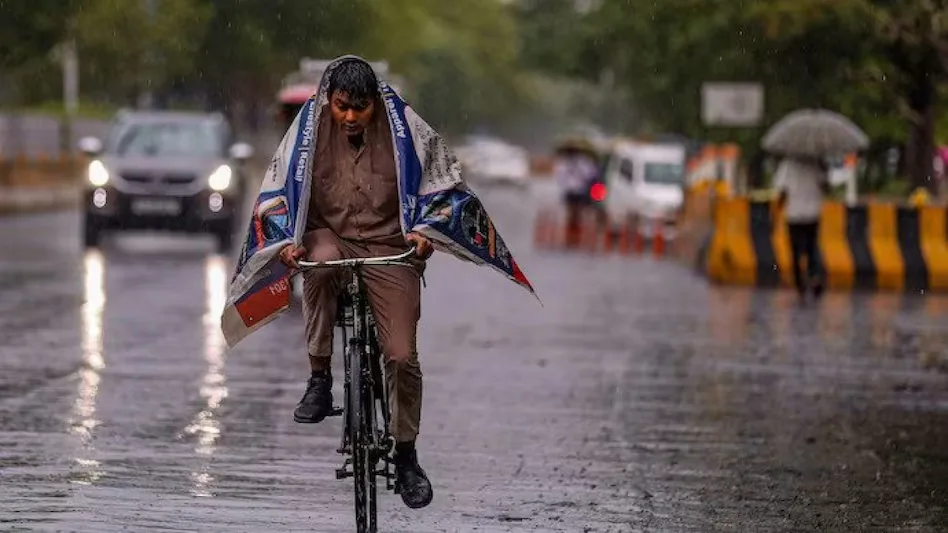
Heavy rains are back! Pune braces for the monsoon revival – Stay updated with hyperlocal alerts and weather insights on puneripages.in.
Table of Contents
☔ Introduction
After nearly two weeks of subdued and scattered rainfall, the Indian monsoon revival is finally showing promising signs of revival. The India Meteorological Department (IMD) has issued updated forecasts indicating a significant surge in monsoon activity across Pune, Maharashtra, and other central regions. As per meteorological data, heavy to very heavy rainfall is highly probable between June 12 and June 14, 2025, bringing much-needed relief to both urban residents and farmers. This development is not just a welcome break from the dry spell but is also crucial for agriculture, water storage, environmental balance, and city infrastructure resilience. The return of the monsoon sets the stage for Pune’s transition into a cooler, greener phase—marking a shift from water tanker reliance to natural water replenishment, improving outdoor air quality, and bringing much-needed comfort to daily commuters and residents alike.
🌦️ Weather Update: What’s Happening Now?
The monsoon had temporarily stalled in early June, entering a break phase due to weak moisture transport and high atmospheric pressure zones. As a result, Pune and its surrounding regions experienced soaring temperatures, muggy weather, and dry conditions. However, meteorological experts now confirm that two low-pressure systems—one developing over the Bay of Bengal and another over the Arabian Sea—are reigniting the monsoon momentum. These systems are pulling in moisture-laden winds from the ocean, leading to intensified cloud formation over the Western Ghats, Konkan Coast, and Deccan Plateau. Current satellite imagery also shows increasing vertical development of cumulonimbus clouds, indicating the arrival of heavy showers.
📍 Pune Forecast: What to Expect
According to IMD Pune, the following conditions are expected over the next few days:

- June 11: Cloudy skies with light, scattered showers across city and suburbs
- June 12: Onset of moderate rainfall in most areas including Shivajinagar, Katraj, and Baner
- June 13–14: Widespread heavy to very heavy rain expected in both urban and rural zones
- Temperature drop: Daytime highs will fall to 28–30°C, with night temperatures settling around 22°C
⚠️ Alerts for Residents
- Flash Flood Alerts: Issued for low-lying areas prone to sudden water accumulation.
- Waterlogging Warnings: Specific to densely populated zones such as Kothrud, Camp, Hadapsar, and Viman Nagar.
Citizens are strongly advised to monitor updates from city corporations, avoid flood-prone routes, and plan daily commutes accordingly.
🌾 Why This Rain Matters
The revival of the monsoon has widespread implications for several sectors:
- Agriculture: Farmers in Maharashtra’s rain-fed zones, especially in Marathwada and Vidarbha, had delayed Kharif crop sowing due to lack of moisture. Timely rain will now allow them to begin planting paddy, soybean, and pulses.
- Water Resources: Major reservoirs and lakes, including Khadakwasla Dam and Panshet Dam, were showing receding water levels. The rainfall is crucial for replenishing drinking water sources.
- Urban Ecology: City gardens, green spaces, and rooftop farms will flourish, supporting biodiversity and urban cooling. Notable examples like Empress Garden in Camp and Osho Teerth Park in Koregaon Park will thrive with fresh foliage, seasonal blooms, and healthier air. Rooftop gardens will become more vibrant, reducing heat retention and improving building insulation. This lush transformation of urban landscapes contributes to a more sustainable, breathable city environment during the monsoon season.
- Air Quality: With dust and particulate matter being washed away, Pune’s air quality index (AQI) is expected to significantly improve.
⚠️ Risks & Precautions
Despite its benefits, the incoming monsoon rains also bring challenges:
- Flooded roads and traffic snarls, especially during peak hours
- Power outages in areas with aging or exposed electrical grids
- Increased risk of mosquito-borne illnesses like dengue and malaria due to stagnant water accumulation, particularly in waterlogged pockets of Pune. The Pune Municipal Corporation (PMC) has already begun anti-larval drives in sensitive zones such as Warje, Vishrantwadi, and Wanowrie. Citizens are advised to regularly empty standing water containers, use mosquito repellents, and contact PMC helplines in case of suspected breeding sites.
Precaution Tips:
![safety tips for monsoon revival in june]](https://puneripages.in/wp-content/uploads/2025/06/image-61-1024x486.webp)
- Carry raincoats and umbrellas during commutes
- Avoid traveling during heavy downpours unless necessary
- Clear roof drains and check household water storage for leaks
- Apply mosquito repellent and use nets
City authorities are already deploying emergency crews and desilting stormwater drains to reduce urban flooding.
🛰️ Meteorological Insight
Advanced weather modeling shows strong indicators of sustained monsoon activity. The monsoon trough, a belt of low pressure, is expected to shift southward over central India. This will align with cyclonic circulations forming off both coasts, increasing the inflow of humid winds.
Meteorological data from INSAT satellites and Doppler radar stations across Maharashtra reveal high vertical cloud development and growing wind convergence zones. Experts also forecast a potential low-pressure area strengthening into a depression by mid-June, which may further enhance rainfall in western India.
🧘 Final Thoughts
The monsoon’s long-awaited return is not just a shift in weather but a harbinger of renewal and balance. From farmers sowing seeds to children splashing in puddles, the rains signal the season of rejuvenation. The transition impacts everyday life—reducing dependence on water tankers, refreshing Pune’s parched greenery, and improving outdoor air quality, making walks and commutes more pleasant. It also means cooler temperatures, fuller reservoirs, and cleaner streets.
As Pune prepares to embrace the showers, it’s essential to remain alert, responsible, and appreciative of nature’s rhythms. ⚠️ Stay tuned to IMD bulletins, follow Pune Municipal Corporation (PMC) updates, and bookmark puneripages.in for hyperlocal alerts, safety tips, and daily monsoon coverage tailored for Pune’s residents.
❓ FAQs
Q1: When will Pune experience the heaviest rainfall?
Between June 12 and June 14, 2025, with the highest rainfall intensity expected on June 13.
Q2: Which areas in Pune are most prone to waterlogging?
Kothrud, Camp, Hadapsar, and Viman Nagar are among the most vulnerable areas during heavy rainfall.
Q3: How can I receive real-time rain alerts in Pune?
Follow IMD Pune’s Twitter handle, tune into local news channels, or visit puneripages.in for daily updates and alerts.
Q4: What should farmers do during this monsoon revival?
Begin Kharif sowing as soon as adequate soil moisture is observed. Monitor updates from the Agriculture Department.
Q5: What health precautions should I take during the monsoon?
Use mosquito repellents, drain stagnant water around your home, and report breeding sites to PMC. Carry rain gear to avoid getting soaked.
Q6: Will public transport be affected during heavy rains?
Yes, delays and reroutes are expected. PMPML buses may face slowdowns on waterlogged roads.
Q7: Are there any apps to monitor rain and flood alerts in Pune?
Yes, use the Mausam app by IMD or the PMC Flood Alert app for real-time notifications.
Q8: How do monsoons affect school and work schedules in Pune?
Schools may declare holidays in case of red alerts. Companies often shift to remote work or flexible hours during extreme weather.
Q9: What emergency numbers should I keep handy?
Dial PMC Helpline: 1800-103-0222 or Disaster Management Control Room: 020-25506800 for flood-related emergencies.
Q10: Can pets be affected by monsoon changes?
Yes. Keep pets indoors during storms, ensure dry bedding, and consult vets for any monsoon-related health issues.






